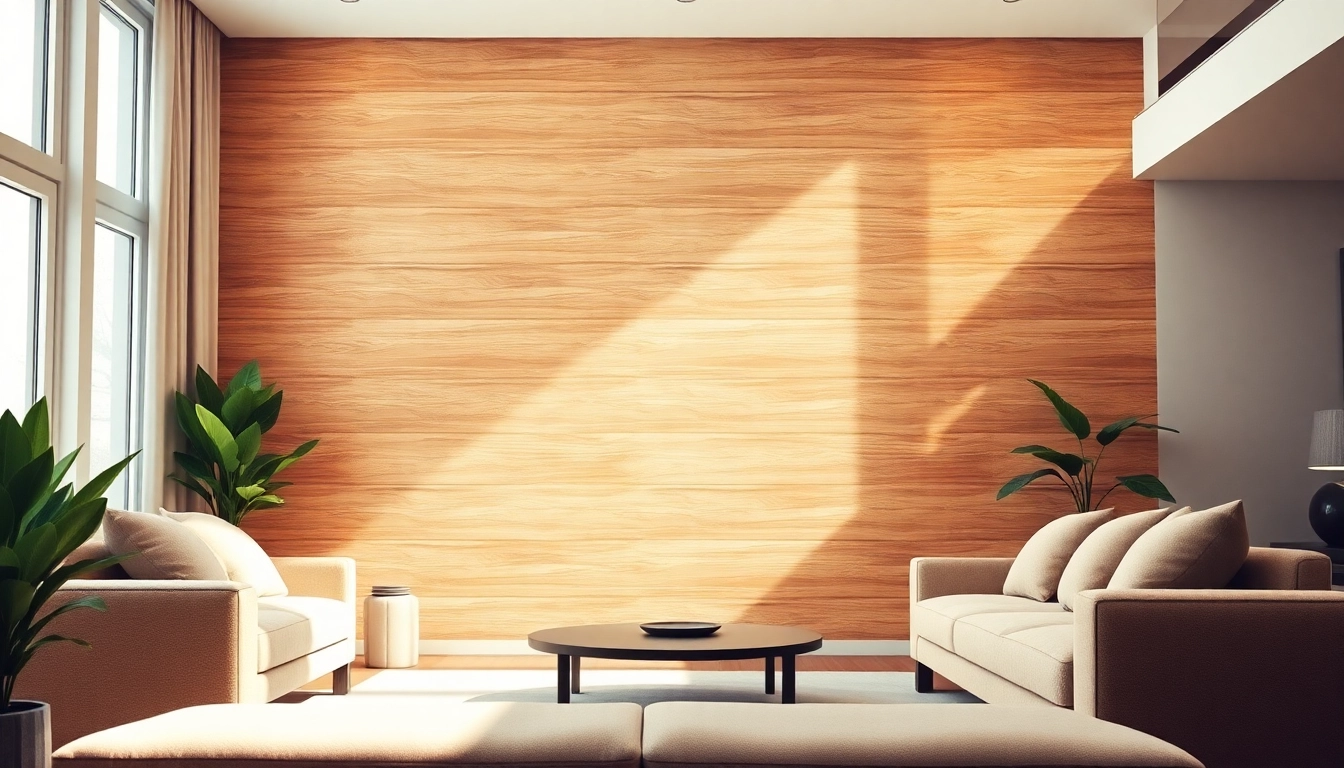Elevate Your Home Aesthetic with Faux Wood Wall Designs
Understanding Faux Wood Wall Appeal
The allure of faux wood wall designs lies in their ability to offer the timeless charm of natural wood without the complexities associated with its maintenance and cost. With advancements in technology and design, faux wood has become an increasingly popular choice for architects, designers, and homeowners alike. This versatile material brings warmth and sophistication to spaces, making it a desirable choice for a variety of applications.
The Aesthetic Benefits of Faux Wood Wall
The visual appeal of faux wood walls is one of their most significant advantages. Available in multiple styles, colors, and textures, faux wood can seamlessly emulate the richness of traditional wood. These panels allow homeowners and business owners to achieve a high-end look without substantial budget requirements. When installed, faux wood walls can create a stunning focal point, contributing to an environment that feels both inviting and luxurious.
Moreover, faux wood is not limited to just one type of woodgrain; it can replicate various wood finishes, from rustic barn woods to sleek modern finishes. This diversity means that whether you’re aiming for a cozy, cabin-like atmosphere or a clean, contemporary feel, there’s a faux wood wall option to fit your design scheme.
Durability and Maintenance of Faux Wood Wall
Durability is where faux wood walls shine significantly. Unlike traditional wood, which can warp, crack, or suffer from pest infestations, faux wood walls are often crafted from materials that are resistant to these problems. Many faux wood products come with warranties that assure longevity, making them a sound investment for any project.
In terms of maintenance, faux wood walls require far less upkeep than their natural counterparts. A simple wipe down with a damp cloth is often sufficient, eliminating the need for regular sanding, staining, or sealing. This ease of maintenance makes faux wood a practical choice, especially in high-traffic areas or spaces that are subject to moisture, such as kitchens or bathrooms.
Eco-Friendly Options for Faux Wood Wall
As environmental consciousness grows among consumers, many faux wood products are now made from recycled materials or sustainably sourced products. Choosing eco-friendly faux wood walls helps reduce the demand for timber harvesting, significantly lowering the environmental footprint associated with constructing and furnishing interiors. With these options, users can feel good about their choices, aligning their aesthetic goals with sustainability values.
Additionally, many manufacturers are adopting practices to create their faux wood panels with non-toxic materials and finishes, which can contribute to healthier indoor air quality. This aspect is particularly appealing to families, as well as commercial spaces that prioritize the wellness of their occupants.
Versatile Applications of Faux Wood Wall
The versatility of faux wood walls allows them to serve numerous purposes in various environments. From residential homes seeking warmth to commercial infrastructure aiming for a stylish edge, faux wood panels can fit any design challenge.
Faux Wood Wall in Residential Spaces
In homes, faux wood walls can be utilized in exciting ways. One common application is within living rooms, where the panels can serve as an accent wall behind a fireplace or television. This creates a cozy atmosphere while remaining practical and stylish. In bedrooms, faux wood can help create a calming environment, working harmoniously with other natural textures like linens and cottons.
Moreover, faux wood walls can dramatically enhance small spaces. For instance, by creating an illusion of depth with horizontal paneling, homeowners can make a narrow hallway appear wider or articulate specific areas within an open floor plan.
Faux Wood Wall for Commercial Environments
In commercial settings, faux wood walls have found their niche in creating inviting environments that reflect brand identity. Restaurants, cafés, and retail stores use faux wood to craft unique interiors that make a lasting impression on customers. Studies show that an aesthetically pleasing environment encourages longer visits, enhancing customer satisfaction.
Office spaces also benefit from the inclusion of faux wood walls. In such environments, these panels can break the monotony of an otherwise sterile design, creating collaborative zones that promote creativity and teamwork among employees.
Creative Uses of Faux Wood Wall in DIY Projects
For the crafty individual, faux wood walls present countless opportunities for DIY projects. Creative homeowners can utilize faux wood panels to make everything from headboards to custom shelving units. The lightweight nature of many faux wood types makes them easier to handle, enabling even novice DIYers to complete impressive projects without the need for extensive construction experience.
Additionally, faux wood can be used in unique decorative features. For example, adding a faux wood accent in an unexpected location, like the back of a kitchen island or within a hallway nook, can create an element of surprise that enhances the overall design theme.
Choosing the Right Faux Wood Wall
When selecting a faux wood wall, consideration must be taken not just for aesthetic preferences, but for practical implications as well. With various styles, textures, and colors available, understanding how to choose the right option is critical for achieving desired results.
Different Styles and Textures of Faux Wood Wall
Styles of faux wood walls can range from reclaimed wood effects to sleek, contemporary designs. Depending on the decor theme of your space, different styles can either complement or clash with existing elements. Textures also play a critical role in perceived depth and richness of your design. Varied textures can evoke different feelings; for example, a rustic finish may bring warmth and charm, while a more polished surface can contribute to a modern aesthetic.
It’s essential to order samples before making a final decision. This allows you to see how the faux wood interacts with existing colors and furnishings within your space.
Color Schemes for Faux Wood Wall Integration
Integrating color schemes with faux wood walls can elevate the entire ambiance of a room. Warm browns and rich honey hues add comfort and intimacy, while cooler gray tones can provide a sleek, modern look. Choosing the right color can help tie different elements of your decor together, creating a cohesive design.
Furthermore, contrasting colors can create stunning effects; pairing light-colored faux wood with darker accents can make spaces visually dynamic and engaging. When considering paint or furniture colors, it’s crucial to achieve balance so that the faux wood doesn’t compete for attention.
Balancing Faux Wood Wall with Other Design Elements
To create a harmonious environment, faux wood walls should complement other design elements in a space. Consideration should be given to the materials, colors, and patterns used in furnishings, fixtures, and other architectural elements. Balancing faux wood walls with soft textiles or vibrant art can soften the look and ensure that the design feels integrated.
Additionally, lighting must not be overlooked. Natural light can accentuate the grain patterns and colors of faux wood, making it a wise choice to utilize strategically placed lighting fixtures to highlight these features.
Installation Tips for Faux Wood Wall
Installing faux wood walls can be a rewarding project, especially when you’re ready to enhance your space. However, proper planning and understanding of the installation process are vital for achieving the best results.
Prepping Your Space for Faux Wood Wall
Prior to installation, ensure that the surface where the panels will be applied is clean, dry, and smooth. Remove any existing wall coverings, and repair any damage to the wall surface to create a flawless base. Proper preparation is essential as it directly affects how well the faux wood will adhere and ultimately perform.
Consider using a level to determine the straightness of walls, as this will help in laying out the panels neatly. Selecting the right adhesive and ensuring its compatibility with the wall surface is also crucial.
Tools Needed for Faux Wood Wall Installation
The installation tools you will need may vary depending on the type of faux wood wall you are using. At a minimum, you should gather the following tools: a level, a measuring tape, a utility knife, and a straightedge for cutting panels. Additionally, having a caulking gun on hand may prove helpful for applying adhesive.
Power tools, such as a nail gun, can simplify the installation process further, especially for larger paneling projects. If you’re not confident using power tools, enlisting the help of a professional installer might be a wise choice.
Common Mistakes to Avoid with Faux Wood Wall
Even a simple installation can come with pitfalls. One common mistake is underestimating the need for acclimation; allowing faux wood panels to adjust to the room temperature and humidity before installation can prevent warping and guarantee optimal performance.
Measuring inaccurately is another frequent issue. Double-checking measurements can save time and money, eliminating the frustration of dealing with wrongly sized panels. Finally, neglecting to wear appropriate safety gear during installation can lead to avoidable accidents.
Measuring the Impact of Faux Wood Wall
Once the installation is complete, assessing the impact of faux wood walls on aesthetics, functionality, and even property value is essential for understanding their contribution to your home or business.
Enhancing Property Value with Faux Wood Wall
Faux wood walls can add substantial aesthetic appeal, which, in turn, can enhance property value. A well-designed interior that incorporates high-quality faux wood can significantly increase the likelihood of a property selling faster and at a better price.
Real estate professionals often note that features like faux wood panels attract potential buyers looking for unique design elements that stand apart from standard finishes. This appeal underscores the importance of investing in quality materials.
User Reviews and Feedback on Faux Wood Wall
Consumer feedback is a valuable asset for measuring the efficacy of faux wood walls. Many users express satisfaction with their aesthetic transformation, noting the positive remarks received from guests and the overall enhancement to their living or working environments. Reviews often highlight the ease of installation and maintenance as key benefits, further driving the appeal.
In addition to personal experiences, case studies and testimonials from consumers can offer insights into the long-term performance and satisfaction of faux wood wall products.
Long-term Care of Faux Wood Wall
Caring for faux wood walls is straightforward, as they generally require periodic cleaning to maintain their appearance. Frequently dust or wipe panels with a damp cloth to retain their beauty. In cases of more challenging stains, mild soap solutions can be effective. Avoid abrasive cleaners or scrubbing pads that can scratch or dull the finish.
Finally, routinely inspect panels for any signs of damage, such as peeling or seams that may need reassessment. Prompt attention to these details can help sustain the quality and longevity of your faux wood wall, ensuring it continues to impress for years to come.












Post Comment